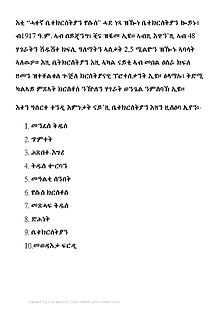Languages of Eritrea
| Languages of Eritrea | |
|---|---|
| Official languages |
Tigrinya[1] Arabic[1] English[1][2] |
| Main immigrant languages | Amharic |
| Main foreign languages | English |
| Sign languages | Eritrean Sign Language, older sign languages |
| Common keyboard layouts |
|
The languages of Eritrea refers to the various spoken forms of communication in Eritrea. It includes the nation's official languages, as well as its minority and foreign languages. The term also encompasses the writing systems traditionally used to transcribe those languages.
Overview

Eritrea's population comprises nine ethnic groups, most of whom speak languages from the Semitic branch of the Afro-Asiatic family. The Semitic languages in Eritrea are Tigre, Tigrinya, the newly-recognized Dahlik, and Arabic (spoken natively by the Rashaida Arabs). Other Afro-Asiatic languages belonging to the Cushitic branch are also widely spoken in the country.[3] The latter include Afar, Beja, Blin and Saho.
In addition, languages belonging to the Nilo-Saharan language family (Kunama and Nara) are spoken as a mother tongue by the Kunama and Nara Nilotic ethnic minorities that live in the north and northwestern part of the country.[3]
English is the predominant foreign language. It is one of three working languages in government as well as the language of instruction from 5th grade and above in all Eritrean schools, including secondary and university education.
| Number | Gender | Near | Far |
|---|---|---|---|
| Singular | Masculine | እዚ ǝzi ... (እዚ ǝzi) | እቲ ǝti ... (እቲ ǝti) |
| Feminine | እዛ ǝza ... (እዚኣ ǝzi’a) | እታ ǝta ... (እቲኣ ǝti’a) | |
| Plural | Masculine | እዞመ ǝzom ... (እዚኦም ǝzi’om) | እቶም ǝtom ... (እቲኦም ǝti’om) |
| Feminine | እዘን ǝzän ... (እዚኤን ǝzi’en) | እተነ ǝtän ... (እቲኤን ǝti’en) |
In terms of writing systems, Eritrea's principal orthography is Ge'ez, Latin script and Arabic script. Ge'ez is employed as an abugida for the two most spoken languages in the country: Tigrinya and Tigre. It first came into usage in the 6th and 5th centuries BC as an abjad to transcribe the Semitic Ge'ez language.[4] Ge'ez now serves as the liturgical language of the Eritrean Orthodox Tewahedo Church and Ethiopian Orthodox Tewahedo Churches.[5] The Latin script is used to write the majority of the country's other languages excluding Arabic. The Arabic script has also been used to write Afar, Beja, Saho and Tigre in the past. However, Tigre is mostly written in Ge'ez script now while the Latin script is used to write the other languages. For example, Qafar Feera, a modified Latin script, serves as an orthography for transcribing Afar.[6]
Language classification
Afro-Asiatic languages
- Semitic languages:
- North Ethiopic languages (South Semitic):
- Tigre
- Tigrinya
- Dahlik, a newly discovered language spoken on the Dahlak Archipelago
- Central Semitic languages:
- North Ethiopic languages (South Semitic):
Nilo-Saharan languages
Indo-European languages
- Indo-European languages:
- Italic languages:
- Romance languages:
- Western Romance languages:
- Italian, mother tongue of Italian Eritreans
- Western Romance languages:
- Romance languages:
- Germanic languages:
- West Germanic languages:
- English language, an official language along with Tigrinya and Arabic[2]
- West Germanic languages:
- Italic languages:
See also
Notes
- ↑ 1.0 1.1 1.2 Hailemariam, Chefena; Kroon, Sjaak; Walters, Joel (1999). "Multilingualism and Nation Building: Language and Education in Eritrea". Journal of Multilingual and Multicultural Development 20 (6): 474–493. Retrieved 2012-04-04.
- ↑ 2.0 2.1 CIA – The World Factbook – Eritrea
- ↑ 3.0 3.1 Minahan, James (1998). Miniature empires: a historical dictionary of the newly independent states. Greenwood Publishing Group. p. 76. ISBN 0313306109. "The majority of the Eritreans speak Semitic or Cushitic languages of the Afro-Asiatic language group. The Kunama, Baria, and other smaller groups in the north and northwest speak Nilotic languages."
- ↑ Rodolfo Fattovich, "Akkälä Guzay" in von Uhlig, Siegbert, ed. Encyclopaedia Aethiopica: A-C. Weissbaden: Otto Harrassowitz KG, 2003, p.169.
- ↑ Pereltsvaig, Asya (2012). Languages of the World: An Introduction. Cambridge University Press. p. 95. ISBN 1107002788.
- ↑ "Afar (ʿAfár af)". Omniglot. Retrieved 23 August 2013.
References
- Woldemikael, Tekle M (April 2003). Language, Education, and Public Policy in Eritrea "Language, Education, and Public Policy in Eritrea". African Studies Review (African Studies Review, Vol. 46, No. 1) 46 (1): 117. doi:10.2307/1514983. JSTOR 1514983. Retrieved 2007-01-27.
Countries.png)